This one isn’t for my friends in the fire service – it’s going to be far too basic for them to take much of an interest. But for everybody else, I thought it might be interesting to take you step by step through a recent car fire that we had. I happened to be wearing my FireCam – a small high-definition camera mounted on the side of my helmet. It recorded the whole shebang from start to finish.
Car fires can be interesting. The first one I ever ran, fourteen years ago, I got the shock of my life when I thought that somebody was opening fire on us with a shotgun. It turns out that the series of loud booms that gave me such a start were the tires, which can often explode when they get hot enough.
Most firefighters like to approach car fires from either the sides or corners, but never the front or the rear. The spring-loaded bumpers/fenders can become projectiles when the car heats up, slamming into anybody unfortunate enough to be standing in the wrong spot, breaking their legs and causing other serious injuries. For similar reasons, we avoid the rear of hatchback vehicles, whose pistons on the flip-up hatch door can also cause some nasty wounds if they go flying off under pressure.
The fire started in the early evening, right after our shift changeover. It was still light out. When the alarm tones dropped, the engine company walked not ran (we never run) to the engine, and got into our protective bunker gear. We’re held to a standard that says we must be into our gear in a minute or less. Our air tanks are mounted behind our seats in the engine, so we are able to shrug into the shoulder harnesses while we are driving toward the scene of the fire, even with our seat belt already in place.
At the scene, the engineer (our driver – some departments on the east coast call them ‘chauffeurs’) positions the engine in what he or she judges to be the best spot, sets the parking brake, chocks the wheels, and then operates the pump. With a little help from our responding ambulance company, the engineer’s water supply is taken care of when one of the firefighters ‘hits the hydrant’ (connects the fire engine up to the fire hydrant and starts water flowing into the pump).
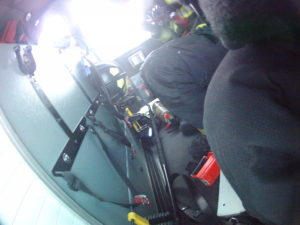
The firefighters grab the tools and other equipment that we think we’ll need, and stage it at the scene. This can include axes, pike poles (think spears, used for extra reach), power saws, and a host of other things from what is, essentially, a million-dollar bright red toolbox on wheels. Then we make for the burning car.
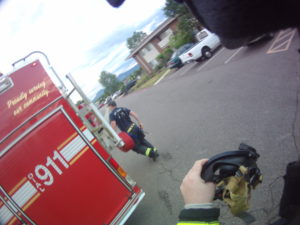
Then we mask up and go on air. Back in the day, firefighters would think nothing of fighting a car fire without breathing protection. There’s a reason that the scourge of cancer is so prevalent among the firefighting community these days. Pretty much everything in your car is toxic and carcinogenic, which means that we don’t want any of it on our skin, let alone in our lungs. We take about thirty seconds to fit our masks, pull the protective Nomex hood up over our faces to guard the skin of our face and neck, then put our helmet back on and tighten the chin-strap securely. Last of all, we reach back, open up the air bottle, and hook the regulator to our mask. The first time you take a breath, the mask sucks in against your face, clicks, and you hear the reassuring flow of positive pressure air flowing into the mask each time you inhale. You also sound like Darth Vader breathing, which is pretty cool no matter how old you are.
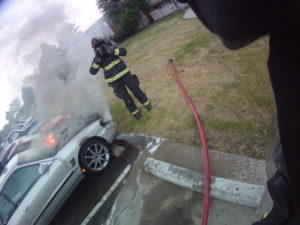
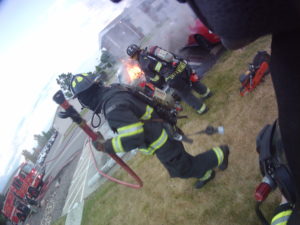
The line usually gets stretched at around this time. Each of the four sides of the fire engine has a hoseline that can be pulled from it. Our bumper line is one and three-quarter inch hose, more than enough for a relatively small fire like this. With a hand signal or a radio transmission, we’ll ask the engineer to send water, what we call “charging the line.” Once the line is charged, we’re ready to hit the fire.
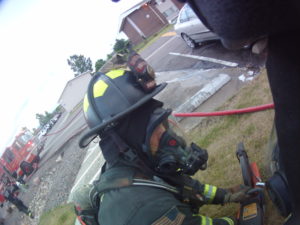
Gaining access to the seat of the fire is critical. The extra tools come in handy for prying, cutting, and otherwise forcing our way into the engine compartment. This can cause a brief increase in the intensity of the fire; when the hood is flipped back, the sudden influx of air feeds the flames.
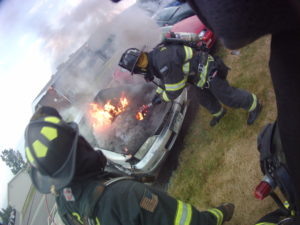
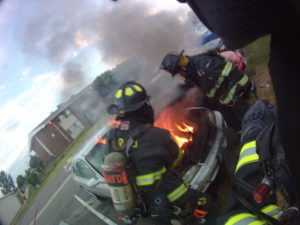
Once the main body of the fire is visible, the firefighter operating the nozzle hits it directly.
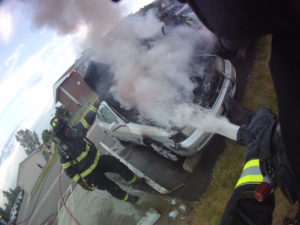
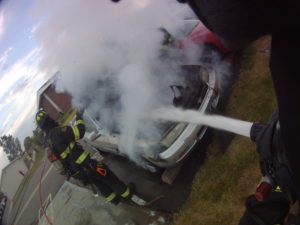
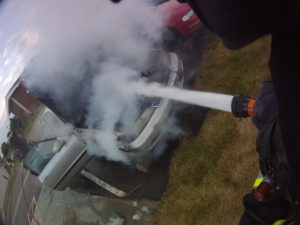
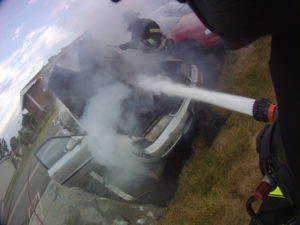
Arson investigators like to arrive as early as possible to help determine the cause of the fire. It helps them greatly to see as much of the original fire condition as they can. In this case, the chief is documenting the extinguishment process with a steady stream of photographs.
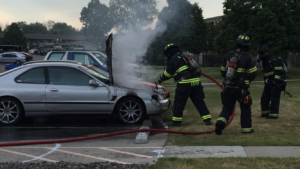
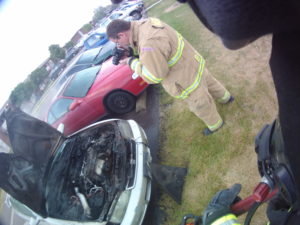
Nobody wants to have a rekindle (the fire breaks out again spontaneously once you’ve left the scene) so during the overhaul phase, firefighters get into the heated interior of the engine block and douse it in water. The goal is to cool things down as much as possible.
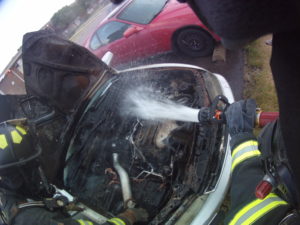
Then we pick up and head home, leaving the scene in the care of the fire investigator, and get everything back in service for the next 911 call. That’s pretty much how a routine car fire goes, although there’s an old saying: there’s no such thing as a routine fire…

